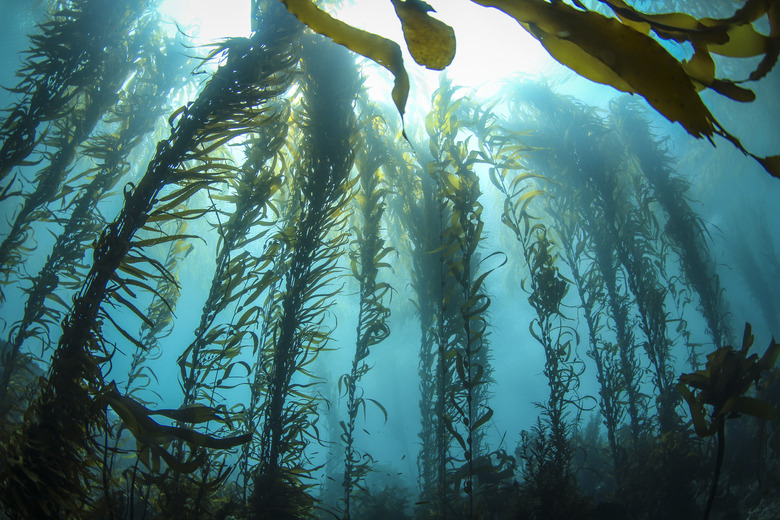List Of Underwater Ocean Plants
While the oceans are home to many species that appear to be plants and that use photosynthesis to create food – such as kelp and phytoplankton – they house few proper plants. Of the true plants, the many seagrass species dominate as the most common plant in the ocean. Along with seagrass, other plantlike species photosynthesize in the ocean to produce around 70 percent of the world's oxygen. They also act as important food sources for both other marine life-forms and humans.
TL;DR (Too Long; Didn't Read)
Though not technically plants, phytoplankton and kelp stand with many seagrass species as marine photosynthesizers that produce the bulk of oxygen on Earth.
Seagrasses Grow in Underwater Fields
Seagrasses Grow in Underwater Fields
The oceans are home to around 72 species of seagrass divided into four families: Zosteraceae, Hydrocharitaceae, Posidoniaceae and Cymodoceaceae. These flowering plants all grow in saline conditions affixed to the ocean floor by root systems, which stabilize the sediment in which they grow. Though at times seagrass groupings can be patchy due to strong currents, large areas of the seabed can be covered in seagrass for miles. Scientists discovered the majority of these species in the world's tropical regions and in shallow regions down to about 160 feet below sea level. Seagrass fields consist of thousands of plants with long, thin leaves that provide food and shelter for many marine species. Other species of proper plants such as mangroves grow near the ocean but spend their life cycles above ocean levels.
Kelp Forests Grow Quickly
Kelp Forests Grow Quickly
Like proper plants, kelp uses photosynthesis to turn water, carbon dioxide and sunlight into food. However, unlike plants, kelp exist in the kingdom Protista, which contains mainly single-celled organisms. Kelp is the largest member of the broad seaweed category, though there are smaller members like rockweed and gulfweed that float freely in the water. Some kelp, which are large species of algae, can grow their broad-leafed bodies 2 feet in a single day. Kelp leaves float thanks to pockets of air. If an individual grows tall enough to touch the surface, it keeps growing. Kelp affixes to the ocean floor using a holdfast, which is similar to a plant's roots, but kelp do not take in nutrients using them. Kelp forests provide homes for many marine species, and humans use kelp for food and other products.
Phytoplankton Are Essential to Life on Earth
Phytoplankton Are Essential to Life on Earth
Despite their name – "phyto" is Greek for plant – creatures categorized as phytoplankton usually belong to the Protista kingdom. Individually, these species are too small to see with the naked eye, but they clump together in large, visible groups. Like kelp and seagrass, phytoplankton photosynthesize. Some scientists believe that one species of the category, Prochlorococcus, weighs in as the top photosynthesizing creature on Earth. Besides providing the world with countless tons of oxygen, these microscopic and occasionally single-celled creatures also provide food for higher orders of life, including whales.
References
- Marine Parks WA: Seaweeds
- Earth Observatory: What Are Phytoplankton?
- Marine Bio: Forests of the Sea: Phytoplankton and Marine plants
- Ocean Portal: Seagrass and Seagrass Beds
- National Geographic Society: Save the Plankton, Breathe Freely
- Encyclopaedia Britannica: Kelp
- National Ocean Service: What Are Phytoplankton
- Oceana: Giant Kelp
- Encyclopaedia Britannica: Seaweed
- Encyclopaedia Britannica: Fucus
- Encyclopaedia Britannica: Sargassum
Cite This Article
MLA
Johnson, Doug. "List Of Underwater Ocean Plants" sciencing.com, https://www.sciencing.com/list-underwater-ocean-plants-6636223/. 17 April 2018.
APA
Johnson, Doug. (2018, April 17). List Of Underwater Ocean Plants. sciencing.com. Retrieved from https://www.sciencing.com/list-underwater-ocean-plants-6636223/
Chicago
Johnson, Doug. List Of Underwater Ocean Plants last modified March 24, 2022. https://www.sciencing.com/list-underwater-ocean-plants-6636223/
